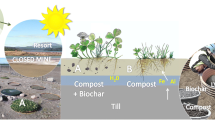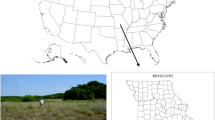Abstract
High metal waste materials from historic mining at the Bunker Hill, Idaho (ID) Superfund site was amended with a range of materials including municipal biosolids, woody debris, wood ash, pulp and paper sludge, and compost. The existing soil or waste material has elevated metal concentrations with total Zn, Pb and Cd ranging from 6000 to 14 700, 2100 to 27 000 and 9 to 28 mg kg−1, respectively. Surface application of certain amendments including biosolids mixed with wood ash resulted in significant decreases in subsoil acidity as well as subsoil extractable metals. This mixture was sufficient to restore a plant cover to the contaminated areas. At the Bunker Hill site, a surface application of high N biosolids (44 or 66 tons ha−1) in combination with wood ash (220 tons ha−1) with or without log yard debris (20% by volume) or pulp and paper sludge (44 tons ha−1) was able to restore a vegetative cover to the metal contaminated materials for 2 years following amendment application. Plant biomass in 1999 was 0.01 mg ha−1 in the control versus a mean of 3.4 tons ha−1 in the residual amended plots. Metal concentrations of the vegetation indicated that plants were within normal concentrations for the 2 years that data were collected. Surface application of amendments was also able to reduce Ca(NO3)2 extractable Zn in the subsoil from about 50 mg kg−1in the control to less than 4 mg kg−1in two of the treatments. Use of conventional amendments including lime alone and microbial stimulants were not sufficient to support plant growth. These results indicate that surface application of biosolids in combination with other residuals is sufficient to restore a vegetative cover to high metal mine wastes.
Similar content being viewed by others
References
Abbott D E, Essington M E, Mullen M D and Ammons J T 2001 Fly ash and lime-stabilized biosolid mixtures in mine spoil reclamation: simulated weathering. J. Environ. Qual. 30: 608–616.
Brown S and Chaney R 2000 Combining by-products to achieve specific soil amendment objectives. In Ed. J M Bartels Land Application of Agricultural, Industrial, and Municipal By-Products. pp. 343–360. Soil Science Society of America, Inc. Madison, WI.
Brown S L, Chaney R L, Angle J S and Ryan J A 1998 Organic carbon and the phytoavailability of cadmium to lettuce in long term biosolids amended soils. J. Environ. Qual. V27, 1071–1078.
Brown S L, Henry C L, Compton H, Chaney R L and DeVolder P 2000 Using municipal biosolids in combination with other residuals to restore a vegetative cover on heavy metal mine tailings. P. 665–670. In Proc. 2000 Natl. Meet. Am. Soc. Surf. Mining and Reclam. Ed.W L Daniels and S G Richardson. Tampa, FA 11– 15 June. Tampa. ASSMR, WV.
Campbell A G 1990 Recycling and disposing of wood ash. Tappi J. 1990, 141–146.
Carpenter A F and Fernandez I J 2000 Pulp sludge as a component in manufactured topsoil. J. Environ. Qual. 29, 387–397.
Chaney R L 1993 Zinc phytotoxicity. In Zinc in Soils and Plants. Eds. A D Robson. Kluwer Academic, Dordrecht, The Netherlands.
Christiansen B and Brown S 2001 Assessment of methods for in situ remediation of heavy metal contaminated soils. In Proc. 6th International Conference on the Biogeochemistry of Trace Elements. University of Guelph, Guelph, Ontario, Canada 29 July – 2 August. p. 36.
Conder J M, Lanno R P, and N T Basta 2001 Assessment of metal availability in smelter soil using earthworms and chemical extractions. J. Environ. Qual. 30, 1231–1237.
Gorman J M, Sencindiver J C, Horvath D J, Singh R N and Keefer R F 2000 Erodibility of fly ash used as a topsoil substitute in mineland reclamation. J. Environ. Qual. 29, 805–811.
Haering K C, Daniels W L, and Feagly S E 2000 Reclaiming mined lands with biosolids, manures and papermill sludges. In Reclamation of Drastically Disturbed Lands. Eds. R. Barnhisel. pp. 615–644. Soil Science Society of America, Inc., Madison, WI.
Henry C L 1986 Growth response, mortality, and foliar nitrogen concentrations of four tree species treated with pulp and paper and municipal sludges. In The Forest Alternative for treatment and Utilization of Municipal and Industrial Wastes. Eds. D W Cole et al. pp. 258–265. Univ. ofWashington Press, Seattle, WA.
Li R S and Daniels W L 1997 Reclamation of coal refuse with a peppermill sludge amendment. In Proc. 1997 Natl. Meet. Am. Soc. Surf. Mining and Reclam. Austin, TX 10–15 May. Eds. J E Brandt et al. pp. 277–290. ASSMR, Princeton, WV.
Li Z, Ryan J A, and Chen J L 2000 Cadmium adsorption on iron oxides, humic substances, and sewage sludge. American Chemical Society. Division of Environmental Chemistry. Preprints of extended abstracts. 40, 8–9
Logan, T J and Chaney R L 1983 Utilization of municipal wastewater and sludge on land– metals. In Proceedings of the Workshop on Utilization of Municipal Wastewater and Sludge on Land. pp. 235–326.
Marschner H 1995 Mineral Nutrition of Higher Plants. Academic Press, New York.
McGrath S P and Cunliffe C H 1985 A simplified method for the extraction of the metals Fe, Zn, Cu, Ni, Cd, Pb, Cr, Co, and Mn from soils and sewage sludges. J. Sci. Food Agric. 36, 794–798.
Ohno T 1992 Neutralization of soil acidity and release of phosphorus and potassium by wood ash. J. Environ. Qual. 21, 433–438.
Sabey B R, Agbim N N and Markstrom D C 1975 Land application of sewage sludge: nitrate accumulation and wheat growth resulting from addition of sewage sludge and wood wastes to soil. J. Environ. Qual. 4, 388–393.
SAS Institute 1990 SAS User's Guide: Statistics. 4th edn. SAS Inst., Cary, NC.
Silverman J 2001 IT Corp. cleaning up topsoil mess: Damaged fields being restored after soil layer removed to cover BunkerHill Superfund site. Spokesman Review, SpokaneWA. June 29, 2001.
Sopper W E 1993 Municipal Sludge use for Land Reclamation. Lewis Publishers, Ann Arbor, MI.
Stuczynski T, Daniels W L, Pantuck K and Pistelok F 1997 Stabilization and revegetation of metal smelter wastes in Poland. National Meeting of the American Society for Surface Mining and Reclamation. Austin, TX, May 1– 5, 1996.
Svendsen A J, Brown S L, and Henry C L 2001 Use of biosolids and lime to ameliorate subsoil acidity in mine tailings. In Proc. 6th International Conference on the Biogeochemistry of Trace Elements. University of Guelph, Guelph, Ontario, Canada 29 July – 2 August. p. 36.
Vangronsveld J, Sterckx J, Van Assche F, and Clijsters H 1995 Rehabilitation studies on an old non-ferrous waste dumping ground: effects of revegetation and metal immobilization by beringite. J. Geochem. Exploration 52, 221–229.
Zhu D A Schwab P and Banks M K 1999 Heavy metal leaching from mine tailings as affected by plants. J. Environ. Qual.. 28, 1727–1732.
Author information
Authors and Affiliations
Corresponding author
Rights and permissions
About this article
Cite this article
Brown, S.L., Henry, C.L., Chaney, R. et al. Using municipal biosolids in combination with other residuals to restore metal-contaminated mining areas. Plant and Soil 249, 203–215 (2003). https://doi.org/10.1023/A:1022558013310
Issue Date:
DOI: https://doi.org/10.1023/A:1022558013310




